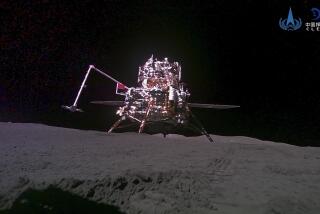Soviet Spacecraft Snaps Martian Moon
- Share via
An unmanned Soviet space probe has begun sending back the first close-up pictures ever taken of Phobos, one of the two small moons of Mars, reaching one of the most critical milestones in the most ambitious planetary mission the Soviets have ever attempted.
Western scientists had been somewhat concerned over the condition of several instruments aboard the small spacecraft, called Phobos 2, and it was not known until Tuesday, Moscow time, whether the television camera would work. But those fears were eased when the Soviet news agency Tass announced that the craft began beaming back images of the tiny, pockmarked moon.
‘It’s Just Great’
“A high-quality image of Phobos from various angles was recorded on nine television sequences,” Tass said in a dispatch from the flight control center in Moscow.
“That’s terrific news,” said Louis Friedman of the Pasadena-based Planetary Society, who was in Moscow earlier this month consulting with Soviet space officials. “When I was over there, just about all of the instruments were working. They now have a completely operating science payload. It’s just great.”
Although the craft is equipped with a wide range of instruments to study the Martian system, the photographs, which have not yet been released, are especially important to scientists because they provide visual data, and they are essential to public understanding and enthusiasm for planetary missions.
Phobos 2 was launched from the Soviet spaceport in central Asia on July 12, five days after a nearly identical probe was sent on what was to have been an identical mission. But the earlier probe was lost last September when a ground controller sent the craft an erroneous computer command that caused it to tilt so that its antenna was no longer pointed to Earth.
That prohibited Soviet scientists from contacting the probe again, leaving Phobos 2 the only survivor in the ambitious mission.
Phobos 2 arrived near Mars in January and began orbiting the Red Planet on Jan. 29, conducting studies of Mars. But the main show will come toward the end of March when the small spacecraft is to zip to within 150 feet of the surface of the tiny moon and send two landers down to the surface.
One of the landers, called a hopper, will literally hop around on Phobos, which is only about nine miles in diameter, sampling the soil and broadcasting data back to the spacecraft for relay back to Earth. The U.S. National Aeronautics and Space Administration will use its antennas to help record the data for the Soviets.
Since the small moon has such a weak gravitational field, a second lander will fire a harpoon into Phobos and reel itself down. Instruments aboard that lander will carry out several experiments, including vaporizing the soil to determine its chemical composition.
Considerable Interest
Phobos is of considerable interest to scientists because it could be an asteroid captured by Mars’ gravitational field, and as such would be one of the solar system’s most primitive objects. No space instruments have ever reached an asteroid.
Scientists from the 13 nations involved in the project are expected to be in Moscow for the encounter, including 10 from NASA.
Soviet officials have said the Phobos mission is one of several expeditions they expect to carry out before a manned mission to Mars early in the next century. There are no plans to study the other Martian moon, Diemos.
More to Read
Sign up for Essential California
The most important California stories and recommendations in your inbox every morning.
You may occasionally receive promotional content from the Los Angeles Times.













